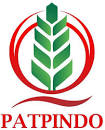EKSPLORASI SENYAWA BIOAKTIF TERIPANG HITAM Holothuria atra ASAL PANTAI PANGANDARAN DAN POTENSINYA SEBAGAI ANTIJAMUR PRODUK PANGAN
Exploration Of Bioactive Compounds Of Black Sea Cucumber (Holothuria atra) and Its Potential as Antifungal Food Product
DOI:
https://doi.org/10.36526/jipang.v6i02.4183Keywords:
Antifungal, Bioactive Compounds, Holothuria atraAbstract
Black sea cucumbers (Holothuria atra.) live in Indonesian waters, especially on the coast of Pangandaran district. Black sea cucumbers are believed to contain bioactive compounds that can have a positive impact on health. Bioactive compounds found in sea cucumbers in several regions in Indonesia have the potential to act as antifungals in food products. Information regarding the potential bioactive compounds of black sea cucumbers (H. atra) in Pangandaran district waters has not been reported. This research aims to determine the bioactive compounds of H. atra in Pangandaran district and their potential as anti-fungal food products. Fresh sea cucumber samples were prepared by removing the entrails, then cutting into 1x1 cm cubes. The black sea cucumbers are then macerated using three types of solvents separately. The three types of solvents used are ethanol, ethyl acetate and n-hexane in a ratio of 1:4. Black sea cucumbers are macerated for 3x24 hours. After that, the extract was evaporated using a rotary evaporator to obtain pure extract. The extract was then calculated for yield, analysis of water content, saponins, flavonoids, phenols, alkaloids and triterpenoids. Calculation of the yield results showed that ethanol was higher, namely 4.9%, while the extract yield using ethyl acetate solvent was 0.28% and the extract yield using n-hexane solvent was 0.75%. The bioactive compounds contained in sea cucumber extract using ethanol, ethyl acetate and n-hexan solvents include flavonoids, phenols and saponins. This shows that sea cucumber extract has the potential to be used as a natural antifungal for food products.
References
Akerina, F. O., & Sangaji, J. (2019). Analisis Fitokimia dan Toksisitas serta Aktivitas Antioksidan Beberapa Jenis Teripang di Desa Kakara, Halmahera Utara. Agrikan: Jurnal Agribisnis Perikanan, 12(2), 188–196. https://doi.org/10.29239/j.agrikan.12.2.188-196
Ardiansyah, A., Rasyid, A., & Nugroho, A. (2019). Uji Antioksidan dan Uji BSLT Pada Ekstrak Kasar Holothuria scabra dengan Berbagai Pelarut. Jurnal Ilmu Dan Teknologi Kelautan Tropis, 11(3), 627–636.
Association of Official Analy-tical Chemists. (2005). Official methods of analysis the association of official analytical chemist 18th edition.
Dini, D. R., Susiana, S., & Suryanti, A. (2020). Kebiasaan makan teripang pasir (Holothuria scabra) dan teripang getah (Holothuria vagabunda) in Karas waters, Batam City, Indonesia. Akuatikisle: Jurnal Akuakultur, Pesisir Dan Pulau-Pulau Kecil, 4(1), 13–19.
Hanifaturahmah, F., Dewanti-Hariyadi, R., Hasanah, U., & Nurilmala, M. (2024). Karakteristik Kimia dan Aktivitas Antioksidan Teripang (Holothuria sp) Segar dan Olahan Secara Tradisional di Papua Barat. Jurnal Pengolahan Hasil Perikanan Indonesia, 27(4), 309–318. https://doi.org/10.17844/jphpi.v27i4.51323
Harborne, J.B. 1987 . Metode Fitokimia. Edisi ke dua, ITB, Bandung
Herliany, N. E., Nofridiansyah, E., & Sasongko, B. (2016). Studi Pengolahan Teripang Kering. Jurnal Enggano, 1(2), 11–19. https://doi.org/10.31186/jenggano.1.2.11-19
Kano, N. N., Losung, F., Mangindaan, R. E. P., Lintang, R. A. J., Wullur, S., & Tumbol, R. A. (2022). Aktivitas Antibakteri dari Teripang Laut yang Diperoleh di Perairan Bunaken. Jurnal Pesisir Dan Laut Tropis, 10(1), 95–101.
Marni, R., Lestari, F., & Susiana, S. (2020). Potensi Ekologis dan Pola Sebaran Teripang Holothuria scabra dan Holothuria vagabunda di Perairan Tanjungkeramat Desa Pangkil, Kabupaten Bintan, Indonesia. Akuatikisle: Jurnal Akuakultur, Pesisir Dan Pulau-Pulau Kecil, 4(1), 7–11. https://doi.org/10.29239/j.akuatikisle.4.1.7-11
Nugroho, A., Harahap, I. A., Ardiansyah, A., Bayu, A., Rasyid, A., Murniasih, T., Setyastuti, A., & Putra, M. Y. (2022). Antioxidant and Antibacterial Activities in 21 Species of Indonesian Sea Cucumbers. Journal of Food Science and Technology, 59(1), 239–248. https://doi.org/10.1007/s13197-021-05007-6
Nurhamzah, L. Y., Agustini, T. W., & Fahmi, A. S. (2022). Stabilitas Antioksidan Ekstrak Teripang Hitam (Holothuria atra) Terhadap Suhu dan Lama Pemanasan. Nutrition Scientific Journal, I(1), 8–20. https://doi.org/10.37058/nsj.v1i1.5897
Rasyid, A., Wahyuningsih, T., & Ardiansyah, A. (2018). Profil Metabolit Sekunder, Aktivitas Antibakteri dan Komposisi Senyawayang Terkandung dalam Ekstrak Metanol Teripang Stichopus horrens. Jurnal Ilmu Dan Teknologi Kelautan Tropis, 10(2), 333–340. https://doi.org/10.29244/jitkt.v10i2.19480
Sari, E. M., Maruf, W. F., & Sumardianto. (2014). Kajian Senyawa Bioaktif Ekstrak Teripang Hitam (Holothuria Edulis) Basah Dan Kering Sebagai Antibakteri Alami. Jurnal Pengolahan Dan Bioteknologi Hasil Perikanan, 3(4), 16–24.
Septiadi, T., Pringgenies, D., & Radjasa, O. K. (2013). Uji Fitokimia dan Aktivitas Antijamur Ekstrak Teripang Keling (Holoturia atra) Dari Pantai Bandengan Jepara Terhadap Jamur Candida albicans. Journal of Marine Research, 2(2), 76–84. http://www.ejournal-s1.undip.ac.id/index.php/jmr/article/view/2355
Downloads
Published
How to Cite
Issue
Section
License
Copyright (c) 2024 Lutfi Yulmiftiyanto Nurhamzah

This work is licensed under a Creative Commons Attribution-ShareAlike 4.0 International License.











